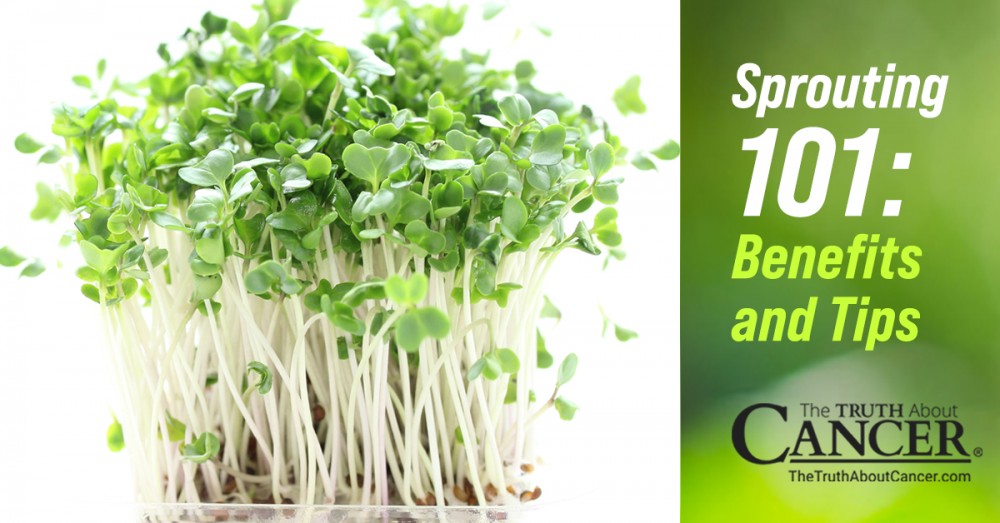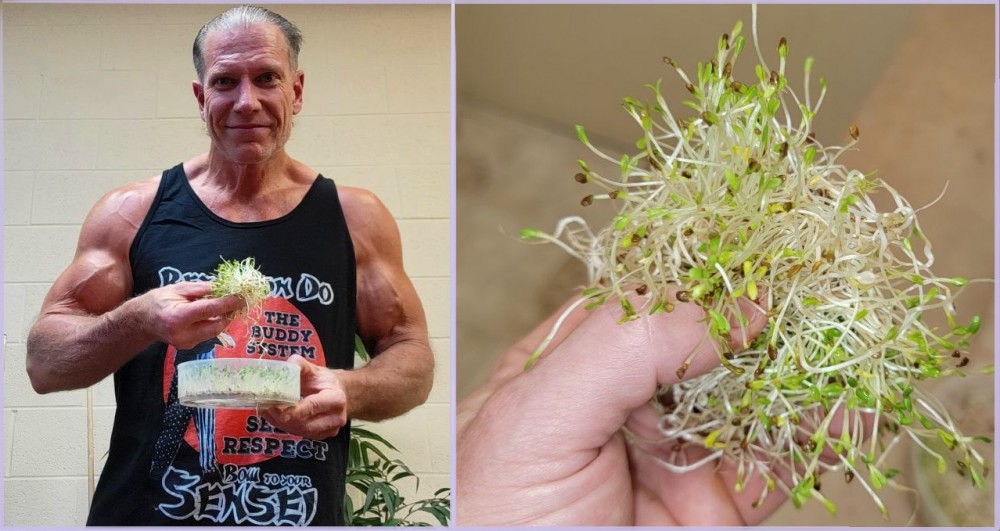Sprouts. They are delicate, tasty, and delicious! I love ’em! But did you know that they are also packed with nutrition, protein, gut-healthy enzymes, and key vitamins and minerals? What’s more, they are super easy and fun to grow! Here is all you need to know about these nutrient-packed morsels and how you can grow them yourself.
My Sprout Obsession
I will let you in on a little secret. I’ve been eating greens, baby greens, and even micro-greens for quite a while now. I started growing sprouts a few years ago, after I interviewed Dr. Joseph Mercola and he mentioned how sprouts are a staple of his daily diet.
It’s so easy. Just sprinkle the seeds in the containers and add water, then rotate about twice a day. It takes me less than 5 minutes a day to grow enough sprouts for the entire family. It takes very little space to grow them, especially since I grow them in stackable sprouting containers, all of which fit easily on a small table in the basement. And within 5-6 days, I get to eat them, and so does everyone else. Charity especially loves them!
Be sure to check out the last section of this article for the 411 on the easiest way to grow sprouts on your own. Growing your own sprouts is absolutely the best (and most economical) way to get your sprouts in every day.
Greens, Microgreens, Baby Greens, and Sprouts
Sprouts are sometimes lumped together in the same category as “microgreens.” However, there is a distinct difference between the two. Micronutrients are green, leafy vegetables (like romaine or kale) that have been growing for about three weeks. They have developed their first tiny leaves, although these leaves are not as developed as they are with baby greens. Microgreens are about 1-3 inches tall.
Sprouts, on the other hand, are consumed after just 2-7 days and have not developed any leaves at all.
What microgreens and sprouts have in common is a wealth of phytonutrients packed into a very small container. As we shall see, however, sprouts have significantly more of those same nutrients.
What Is So Big About Little Sprouts?
Do you want the most “bang for your buck” when it comes to life-giving phytonutrients, vitamins, minerals, and enzymes from food? Get some sprouts in your diet every day! To show you just how nutritious sprouts really are, here is a breakdown of some of the nutritional content found in sprouts:
1 | Enzymes
One of the greatest benefits of eating sprouts is the enzyme content found within them. These enzymes not only help your digestive system to break down the sprouts; they also help you break down and absorb all of your food.
There have also been fascinating studies which associated the antioxidant activity in sprouts with mechanisms that were able to regulate the workings of other enzymes. In particular, a University of Massachusetts study found that sprouts that were germinated for just a short amount of time (2-3 days, for example) had the ability to regulate the enzyme amylase.
Amylase is used in the breakdown of sugars and is usually in extreme dysregulation amongst Type II Diabetics. The metabolic effects of sprouts led the researchers to the obvious conclusion that eating sprouts may be good for helping with some of the key metabolic symptoms of diabetes.
2 | Vitamins
Of course, different kinds of sprouts are going to have different types of key nutrients. In general, however, most sprouts are generally high in vitamins A, C, D, E, and K. Sprouts, in general, are also high in many different forms of B vitamins, including folate (B9), thiamin (B1), pantothenic acid (B5), and riboflavin (B2). They also have a decent amount of choline, which can support the liver, as well as betaine, which helps with protein synthesis.
3 | Minerals
The mineral content in most sprouts is also very high. Key minerals that are found in most sprouts include calcium, iron, magnesium, zinc, manganese, copper, and manganese.
4 | Amino Acids
Amino acids are the building blocks of collagen, which in turn is the building block of healthy tissue growth and repair. If you are interested in looking and feeling younger as you age, then replenishing your collagen supply by getting in some extra essential amino acids in your diet every day is a good idea.
Sprouts have been shown to have a lot more amino acid content than fully grown veggies (up to 30% more according to one study). Another investigation published in the Journal of the Science of Food and Agriculture found that seed germination resulted in higher levels of lysine, methionine, leucine, isoleucine, threonine, phenylalanine, and valine.
5 | Protein
Amino acids are also the basic substances that make up proteins in the body. Since sprouts are packed with amino acids, it makes sense that they would be packed with high amounts of protein as well. Sprout varieties that are the highest in protein are bean sprouts, especially lentils. Sunflower seed sprouts also contain one of the highest protein levels as well.
According to recent research, sprouts, in general, have been connected to benefits for the heart, bones, and detoxification pathways. And as we will see a little bit later, some sprout types actually have anti-cancer substances within them.
Four of the Most Popular and Easy-to-Grow Sprout Varieties
There are dozens of varieties of sprouts out there. Actually, since a sprout is just a newborn plant; any seed, pit, or nut can be sprouted. Here are a few of the most popular ones. These are also the ones that have been analyzed most for their specific nutritional content:
1 | Alfalfa
Alfalfa sprouts are my favorite. I grow them every day. These delicate sprouts come from tiny seeds that produce tiny shoots. They can be a refreshing addition to everything from sandwiches to garnishes for soups. Alfalfa sprouts come from alfalfa wheat and have a large amount of nutrients that can be beneficial for bone strength.
Amongst the nutritional content of alfalfa is a high amount of both calcium and vitamin K. In a study sponsored in part by the U.S. Department of Agriculture (USDA) and Tufts University, “regular consumption” of alfalfa sprouts helped both women and men prevent the beginnings of osteoporosis.
2 | Sunflower
Sunflower seeds are good for more than just road food. You can also sprout them! When you do, you are getting a protein-packed snack since sunflower seed sprouts contain about 25% protein (one of the highest amongst all sprouts).
Sunflower sprouts are also good for the immune system. They contain high amounts of zinc, vitamin B, and vitamin D. In Ayurveda, nutrient-dense sprouts such as sunflower sprouts are said to be good for clearing out congestion and quite beneficial for the lungs in general.
3 | Radish Sprouts
All sprouts are great to eat when you want to support your detoxification pathways. Radish sprouts, however, are especially beneficial for clearing out and strengthening the liver and removing gallstones.
This is because radishes have been found to have substances, especially in their leaves, that can help with the removal of bilirubin. Bilirubin is a yellowish-brown fluid that is created through the breakdown of red blood cells. It is one of the key ingredients in bile.
Some studies also suggest that radish can kick start enzymatic processes which are key for both Phase I and Phase II liver detoxification.
Radish sprouts have a spicy flavor that is refreshing and delightful for people who like a little zest with their meal!
4 | Bean Sprouts
There are several different kinds of bean sprouts that are popular these days. Lentil, mung, garbanzo, and soybean are just a few. Most bean sprouts have big shoots and a hearty flavor, so they make a great addition to stir-fries and even coleslaws.
One of the most awesome things about bean sprouts when it comes to nutrition is their high protein content. Bean sprouts have higher levels of vitamin C and folate (B9) than regular cooked beans. This makes them a hearty source of DNA-repairing antioxidants.
There are benefits for each type of bean. Mung beans are extremely hearty, so they are super easy and fast to grow. Want to go from dried beans to sprouts on your plate in 2 days? Go for the mungs!
Lentils take a little more time to grow (at least 10 days). On the other hand, lentils have a very high protein content and are fairly low in calories, which makes them great for weight loss.
Grow Your Sprouts in 4 Easy Steps
All sprouts, including broccoli sprouts, are pretty easy to grow. What’s more, they don’t take up much space or time. This makes them a great growing option for busy folks or those who live in apartments or condos.
Here are some basic supplies you are going to want to have on hand before you start sprouting:
- Glass jars (wide mouth quart mason jars are great for sprouting), or stackable plastic sprouting containers
- If you’re using a jar – screens, cheesecloth, or a screened lid (this is to cover the opening of the jar to protect them from bugs but also to allow airflow. Most natural health stores sell screened lids that usually fit over quart-sized mason jars)
- Rubber bands (if you are using a screen or a cheesecloth, then the rubber bands will keep this material secure on the top of the jar)
- A location that gets filtered light (if you are doing seeds).
- Between 2 teaspoons and 2 tablespoons of the beans or seeds you want to sprout. The exact amounts will depend on the initial seed or bean. Be sure to read up on how much you need for the size of your jar so that you don’t overpopulate!
Here are the basics of how to sprout in general:
1 | Rinse and then soak the beans or seeds overnight (or for several hours during the day).
Be sure that all seeds or beans are covered with water. This usually means keeping at least two inches of water above the sprouting material. Be sure to use filtered water for soaking.
2 | Drain the water and place the beans or seeds into a clean mason jar or sprouting container.
If you’re using a mason jar, cover with the lid or cloth/screen and lay the jar on its side and distribute the seeds or beans along the bottom so that they are not too stacked on each other. Also, keep the opening of the jar unblocked so that there is plenty of space for air to flow in and out. It is best to put the jar on a cookie sheet or some other portable, flat surface since some water will remain from the soaking.
If you’re using sprouting containers, which is what I use, just put in the seeds, stack them, and let ’em grow!
3 | Keep the jar or containers in your “growing area” (wherever that might be).
Rinse and redistribute the beans or seeds 2-3 times a day. With my stackable sprouting containers, this is super easy, as gravity does all the work.
4 | Depending on the seeds, the remaining germination time could range from between 1 to 10 extra days. Remember to continue to rinse and drain 2-3 times a day during this period as well. When the seed sprouts are from 1/8 inch to 2 inches long, your seeds are ready to eat!
Note: some people are concerned with mold when it comes to sprouting. If you do not pack the seeds in there too tight, make sure to rinse them at least 2-3 times a day, and don’t keep them in a room that is too hot, then this shouldn’t be a problem.
You Can Put Sprouts on Everything!
I have to admit I am really getting a kick out of my little “sprout operation” down in the basement. I am amazed at how fast those little guys grow, and I can also feel the difference in energy, vitality, and even digestion since I’ve been consuming them every day for a couple of years.
Do you need a healthy, fun activity that the whole family can get involved in during the dog days of summer? Want a little more energy and a little less aches, pains, and digestive upset? Consider doing some sprouting, then enjoy a handful or two on your plate every day!
Editor’s note: This post was originally published in 2023 and has been updated and republished in April 2024.




















Where do you buy the seeds in bulk, and how much seed do you have to buy?
Thanks again, Much Love I’ve been watching your videos and reading your posts for quite a while at least a few years maybe 4 or more I lost count, lol, but I Love you all, I do believe you saved my Life, now I’m deeply into Healing, in all Ways , and I’m trying to study and Learn, to develop my unique Gifts , so I can Share God’s Beauty with others… I could write endlessly … Writing is one of Passions 🌿 this seemed like a nice opportunity to write something… God Bless
Where can I get good organic seeds for alfalfa, sunflower and radish sprouts? Or what companies would you recommend? Thank you.